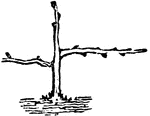Pruning
The Pruning ClipArt gallery offers 21 examples of plant and vine pruning techniques and practices.

Ideal Vine for Cane Renewal
A diagram showing six different parts of a grape vine. These parts include the shoot, cane, arm, branch,…
!["The cross-wire system is another method of training which appears to be confined in this country to the Hudson River Valley, and even there it is used only to a limited extent. But at Juraçon, Bassess-Pyrénées, France, this system is regularly followed. Poles are used in place of the wires, however. [The image] represents vines trained in this manner."—Government Printing Office, 1897](https://etc.usf.edu/clipart/79000/79015/79015_crosswire_mth.gif)
Cross-Wire System of Grape Training
"The cross-wire system is another method of training which appears to be confined in this country to…
!["These [upright] systems are sometimes referred to as the "goblet" systems, since when the shoots are tied together the plant bears a certain resemblance to such a glass. As a rule, these vines make comparatively little growth, and the canes are severely cut back each year."—Government Printing Office, 1897](https://etc.usf.edu/clipart/79000/79013/79013_uprightgrape_mth.gif)
Upright System of Grape Training
"These [upright] systems are sometimes referred to as the "goblet" systems, since when the shoots are…
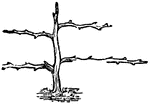
Horizontal Shaped Pruning
"Pruning for Horizontally-Trained Tree, Third Year." — Encyclopedia Britannica, 1893

Plant with Roots Pruned
"This pruning or shortening of the roots causes the production of a new set of fibres from the severed…

When to Prune
"If the plants are too tall or spindling, and you wish to have them dwarf and bushy, cut off the crown…
Pruning
"The nature of the cut itself in pruning is of more consequence, especially in the case of fruit trees,…

Pruning
"The nature of the cut itself in pruning is of more consequence, especially in the case of fruit trees,…
Pruning
"The nature of the cut itself in pruning is of more consequence, especially in the case of fruit trees,…
Pruning
"The nature of the cut itself in pruning is of more consequence, especially in the case of fruit trees,…
Pruning
"The nature of the cut itself in pruning is of more consequence, especially in the case of fruit trees,…
Pruning
"The nature of the cut itself in pruning is of more consequence, especially in the case of fruit trees,…
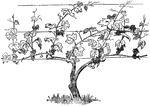
Horizontal Arm Spur System
A diagram of the horizontal arm spur system, depicting the various parts of a vine.
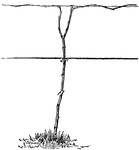
Pruned System According to the Umbrella System
An image depicting a pruned vine that was trained according to the umbrella system. This system is also…
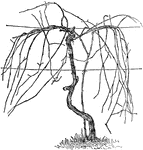
Unpruned Vine According to the Umbrella System
A diagram depicting an unpruned vine trained according to the umbrella system. This image shows stem…
